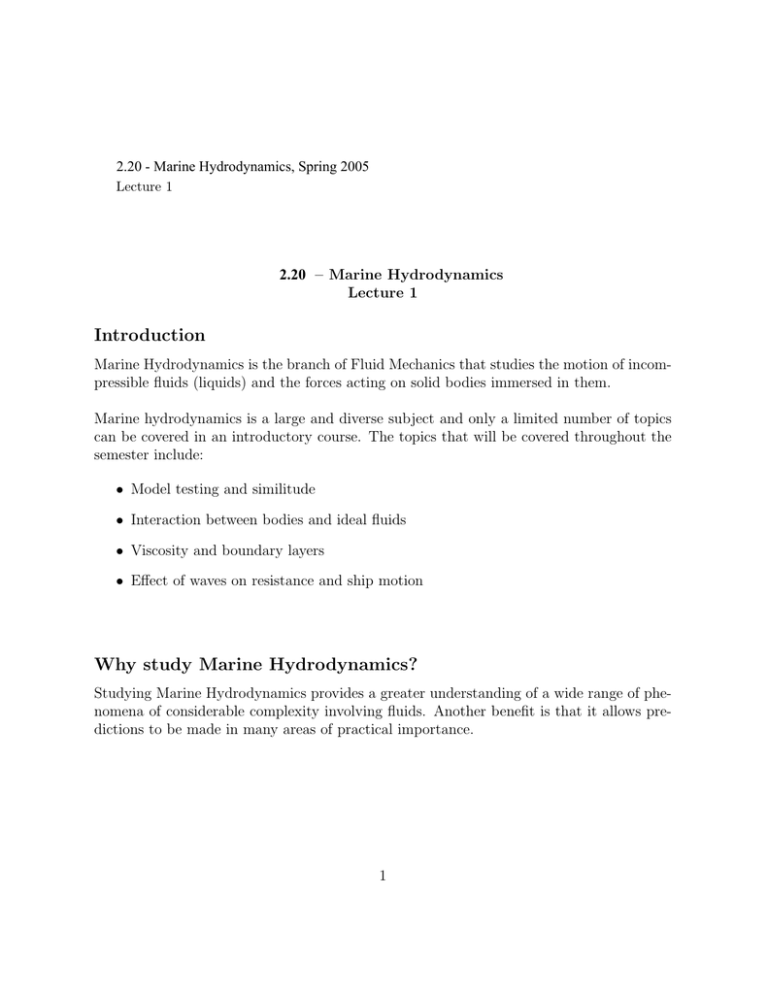Introduction 2.20
advertisement

2.20 - Marine Hydrodynamics, Spring 2005 Lecture 1 2.20 – Marine Hydrodynamics Lecture 1 Introduction Marine Hydrodynamics is the branch of Fluid Mechanics that studies the motion of incom­ pressible fluids (liquids) and the forces acting on solid bodies immersed in them. Marine hydrodynamics is a large and diverse subject and only a limited number of topics can be covered in an introductory course. The topics that will be covered throughout the semester include: • Model testing and similitude • Interaction between bodies and ideal fluids • Viscosity and boundary layers • Effect of waves on resistance and ship motion Why study Marine Hydrodynamics? Studying Marine Hydrodynamics provides a greater understanding of a wide range of phe­ nomena of considerable complexity involving fluids. Another benefit is that it allows pre­ dictions to be made in many areas of practical importance. 1 Fluids vs. Solids In brief, Fluid Mechanics studies the kinematics and dynamics of a group of particles with­ out having to study each particle separately. Most of us have taken some courses on solids or related to solids. Even those who haven’t can get an intuitive feeling about some physical properties of a solid. Thus a comparison of solids and fluids will give some guidelines as to which properties can be translated to fluids and on what terms. Similarities 1. Fundamental laws of mechanics apply to both fluids and solids - Conservation of mass Conservation of momentum (Newton’s law of motion) Conservation of energy (First law of thermodynamics) “particle” size local value measured property 2. Continuum hypothesis is used for both fluids and solids length scale variations due to molecular fluctuations variations due to varying flow O(10-10 – 10-8)m e.g. The smallest measurement scales are in the order of M ∼ 10−5 m → VM ∼ 10−15 m3 . This corresponds to ∼ 3 × 1010 molecules of air in STP or ∼ 1013 molecules of water. 2 Differences 1. Shape - Solids have definite shape Fluids have no preferred shape 2. Constitutive laws Constitutive laws are empirical formulas that relate certain unknown variables. The constitutive laws used in 13.021 relate: dynamics (force, stress ...) to kinematics (position, displacement, velocity ...) Different constitutive laws are used for solids and different for fluids. - For solids Hooke’s law is used to relate stress and strain = f (strain) �stress �� � � �� � force/area relative displacement/length � � N/m2 [m/m] • •• - For solid mechanics ‘statics’ is a dominant aspect For fluids stress is related to rate of strain = f (rate of strain) �stress �� � � �� � force/area velocity gradient � � [1/s] N/m2 • •• Fluids at rest cannot sustain shear force. Fluids have to be moving to be non-trivial. The branch of Fluid Mechanics that studies fluids at rest is referred to as ‘Hydrostatics’. (Archimedes, c 200 BC) Hydrostatics study the trivial case where no stresses due to fluid motion exist. Sometimes distinction between liquids and solids is not a sharp one(honey, jelly, paint, . . . ). Fortunately most common fluids, such as air and water are very close to ”ideal” fluids. 3 Liquids vs. Gasses Liquids and gasses are two categories of fluids. A fluid is ‘a body whose particles move easily among themselves. Fluid is a generic term, including liquids and gasses as species. Water, air, and steam are fluids.’ [1] . A liquid is ‘Being in such a state that the component parts move freely among themselves, but do not tend to separate from each other as the particles of gases and vapors do; neither solid nor aeriform.’[1] A gas is ‘The state of matter distinguished from the solid and liquid states by relatively low density and viscosity, relatively great expansion and contraction with changes in pressure and temperature, the ability to diffuse readily, and the spontaneous tendency to become dis­ tributed uniformly throughout any container.’[2] In brief, a liquid is generally incompressible and does not fill a volume by expanding into it while on the other hand, a gas is compressible and expands to fill any volume containing it. The science that studies the dynamics of liquids is referred to as ‘Hydrodynamics’, while the science that studies the dynamics of gasses is referred to as ‘Aerodynamics’. The main difference between the study of ‘Hydrodynamics’ and the study of ‘Aerodynam­ ics’ is the property of incompressibility. In general hydrodynamic flows are treated as incompressible while aerodynamic flows are treated as compressible. [1] Webster Dictionary [2] American Heritage Dictionary 4 Why is a liquid flow incompressible? It can be shown that the ratio of the characteristic fluid velocities U in a flow to the speed of sound C in the medium gives a measure of compressibility of the medium for that particular flow. This ratio is called the Mach number M . Although the speed of sound in water is of comparable magnitude to the speed of sound in air, the characteristic fluid velocities in water are significantly smaller. Thus in the case of water, the Mach number is very small, indicating that water is virtually incompressible. U : Characteristic fluid flow velocity C : Speed of sound in the medium U M≡ : Mach number C The average speed of sound in air and water is: Cair ∼ 300m/s = 984f t/sec = 583knots Cwater ∼ 1200m/s = 3, 937f t/sec = 2, 333knots Therefore the average ratio of the speed of sound in water to air is because the average water to air density ratio is move in water and therefore, typically, it is: ρwater ρair ∼ 1kg/m3 103 kg/m3 giving thus typical values of Mach numbers in the order of: Mair ∼ O(1) ⇒ COMPRESSIBLE flow Mwater <<1 ⇒ INCOMPRESSIBLE flow 5 ∼ 4. Further on, = 10 , it is ‘harder’ to Uwater <<Uair Note: An incompressible flow does not mean constant density. Cwater Cair 3




